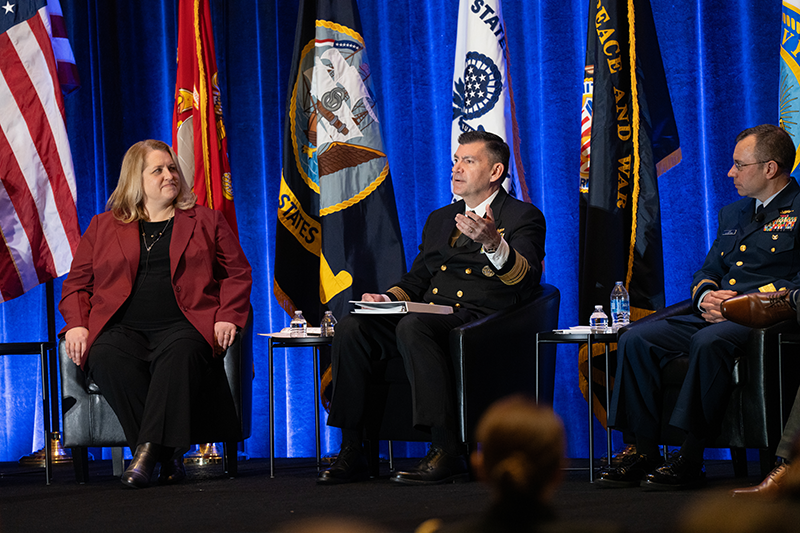
Could private equity investments and business practices jolt the United States’ shipbuilding industry, helping onshore military and commercial capacity to deliver more Navy ships “very fast, very soon,” as President Trump called for in his joint address to Congress last month?
In many ways, yes, argued Benjamin Plum and Christian Rodriguez, associate partners at McKinsey & Company’s Aerospace & Defense Practice, at a Sea-Air-Space 2025 luncheon April 7.
“In shipbuilding,” Plum said, “there’s more appetite for private capital than there has been before because of the stronger demand signals that we’re seeing, both [as] part of this administration but I think more broadly — right? This is a theme that’s continuing.”
Outstripping Capacity
Government, industry, associations and academia have in recent years agonized over ways to increase the speed and scale of shipbuilding — to meet Navy goals for building new ships; upgrading existing ships, submarines, and unmanned systems; and recruiting and training qualified Sailors and mariners. According to a report by the Congressional Budget Office, the 2025 Navy shipbuilding plan calls for 515 “naval platforms,” which includes 381 battle force ships (from 295 today) and 134 unmanned surface and undersea vessels. (The U.S. blue-water flag fleet for international commerce is less than 80 ships.)
“If fully implemented, the plan would eventually result in the fleet’s being larger than it has been at any time since 2001,” CBO said. “However, if the Navy is unable to reduce the maintenance delays that it has been experiencing for more than a decade, it would not be able to deploy as many ships as achieving its 381-ship goal would suggest.”
Speaking at a House Armed Services Committee’s Seapower and Projection Forces Subcommittee hearing last month, Brett A. Seidle, deputy assistant secretary of the Navy for research, development and acquisition, acknowledged the erosion of tier-one shipyards since the end of World War II. Contributing factors, he said in a March 11 DOD News article, include changing Navy requirements, acquisition red tape, worker shortages, and underinvestment and industry consolidation. “Cost and schedule performance remain challenging with deliveries approximately one to three years late and cost rising faster than overall inflation,” he said.
Renewed National Focus
To reduce delays and jumpstart the industry, the Trump administration is reportedly preparing an executive order to revamp the industry, including creating a White House office of shipbuilding focused on the issue. A bipartisan group of lawmakers late last year introduced the SHIPS for America Act, to oversee and provide consistent funding for U.S. maritime policy.
This situation could also present opportunities for private equity to step into the breach, Plum and Rodriguez said at the Sea-Air-Space event. “What we’re starting to see [in shipbuilding] is a desire for a more organized, tiered system like you would see in aerospace,” Plum said.
Risk-averse investors can look to the Navy shipbuilding plan and the federal budget for insights into opportunities in the naval shipbuilding market, Rodriguez said.
According to Plum and Rodriguez, private-capital investments can improve shipyard operations and combat the industry’s perennial problem of retaining skilled workers in the following ways:
- Higher wage levels: “These are very, very difficult jobs that are done often outside in arduous conditions, and I think making sure the entry-level pay rate is right is very important,” Plum said.
- Better quality of facilities: The industry needs climate-protected facilities that make the work doable and attractive.
- Advanced technology: “We have to bring technology to shipbuilding in a way that other industries have done,” Plum said, including incorporating advanced manufacturing “to attract and retain new talent.”
- More outsourcing: The shipbuilding industry is historically involved in every phase of ship construction. However, private companies can implement money-saving process efficiencies and develop modern, modular systems that improve ships, shipbuilding processes, and facilities.
Diversify the Industry
Navy and Coast Guard officials said at an afternoon Sea-Air-Space panel on priority defense investments that the government is doing more strategic outsourcing to spur shipbuilding.
The big yards can push component manufacturing to different locations to better produce on the timelines needed for a 30-year shipbuilding plan, said Gordon Jaquith, executive director of the Department of Navy Relations and vice president and director of the Systems, Tactics, and Force Development Division at CNA, a nonprofit research and analysis firm.
Yet big challenges remain. “The way to onshore an entire industry, meaning shipbuilding, back to the United States is not something we can do overnight,” said Rear Admiral Matt Lake, assistant commandant for resources and chief financial officer at the U.S. Coast Guard.
This requires addressing some of the root causes for stagnation in shipbuilding, he said, including barriers to entry for basic services in areas such as ship design, lack of an ecosystem of suppliers to feed parts into the industrial base, and federal domination that leads to monopolistic practices and undermines diversification.
“To solve that problem and bring shipbuilding back you absolutely have to look at the commercial sector as well,” Lake said.







